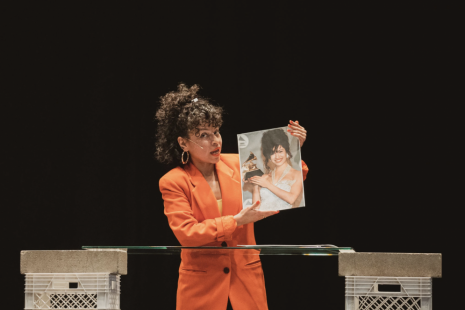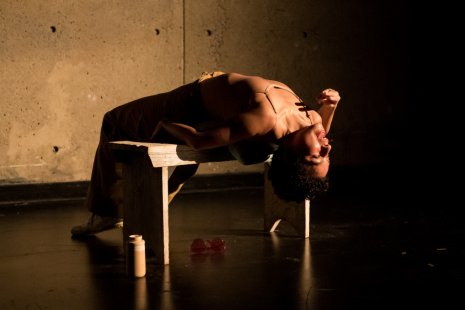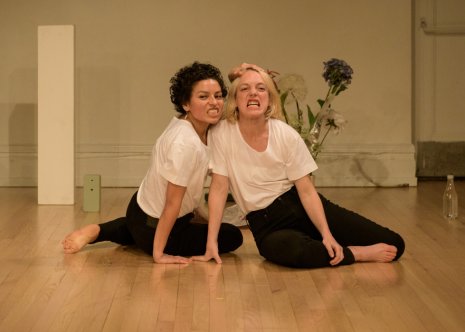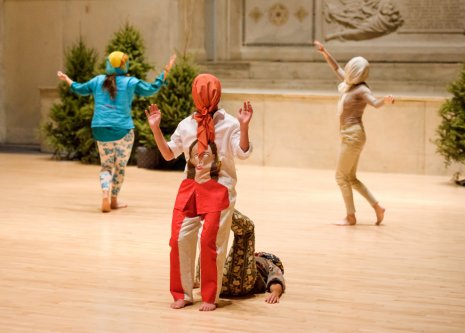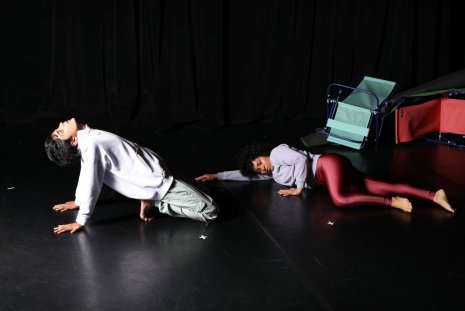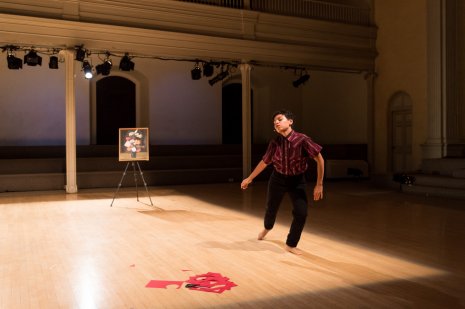In Mariana's Words...
My performances are autobiographical and lyrical in nature and my work reveres the modes of survival of immigrants, queer people of color, and working-class folk. This personal-as-political position challenges my audiences to do more than just witness me. I invite them into critical terrain where they are coaxed toward their own self-reflection. I work to empathize and include and, at times, to dare and confront. In this way, my work is both relational and transgressive.
My performances are made from rigorously ordered sequences where movement, song, and spoken text find the freedom to improvise. A conversational style allows me to play with magnitude and humor by engaging the audience directly as I “read the room” in real time. Moving between vernacular and modern dance forms (cumbia, Graham, Horton, pedestrian, to name a few), my work aims to be familiar and accessible. My props are readymade or domestic objects. I foreground my personal experiences against the broader cultural context, for example, by conjuring a childhood memory of doing domestic work with my grandmother or referencing Barack Obama’s singing of “Amazing Grace” after the 2015 mass shooting in Charleston.
To offer a visualization:
My research into the body’s presence as an act of resistance was foundational in my past performances, “Album” (2018), “Bouquet” (2019), and “Air” (2020), which were all solos. Most recently, I have returned to collaborative work by making choreographic scores that are structurally porous and made to be improvised through. In my current project, “Arrival” I’m digging deeper into this notion of porosity through an investigation of improvisation with musician Jazzy Romero. We propose that the rehearsal process can be the performance. We’re planning-not-to-plan and standing in the moment a bit longer. While the movement and text comes from me, Romero composes the music, often in real time through synth, piano, and vocal instrumentation, to name a few. Developing this practice has led us to center the intricacies of our shared Latina ethnicity—her Salvadorian and Mexican descent and my Guatemalan descent—while also considering our queer, Brown, and first-generation experiences. The practice becomes infused with byproducts of our shared identities—the individual, the collective, and the inherited, vis-à-vis intergenerational transmission. Through an interplay of dance, text, and music, we are relishing in the thrill of finding the unknown through the known; it’s a candid arrival to each other, our forms, and our potential.
“Arrival” responds to the hurdles of making performance in uncertain times and against catastrophic landscapes. The relentlessness and low-grade trauma of the last three years has mandated that I rethink the place of performance in daily life. I have become deeply invested in the idea that improvisational presence carries emancipatory potential. When we lose all other power (safety, predictability, peace) we are left with our bodies and must make use of them, ideally in liberatory ways.
Touring my performance, “Album,” in the UK in 2019, lead to my inquiry of improvisational score-making. The opportunity gave me the ambitious task of touring a solo work, alone. I trekked across the region by train while hauling two carry-on suitcases that held my belongings and the contents of the show. Over two weeks, I had six shows and I leaned into the scrappiness of it all in honor of my devotion to the form, this being the first touring milestone of my career.
I had a routine down: I would arrive in a new town, run tech, dress rehearsal, and opening, all in the same day, sometimes two. I performed at universities, queer bars, dance studios, and black box theaters, counting on three crucial elements: my body, the choreography, and the audience. The process of setting and resetting the same work from one location to the next, without an extra body or another pair of eyes, made me hyper-reliant on the energy of the audience. I flexed deeper into moments of the performance that either landed (or didn’t), depending on the community or our shared experience.
My show in Brighton was at a queer bar and there was a Black Studies conference nearby, which populated the audience with mostly queer people of color. Until that night, I hadn’t yet performed for such a diverse audience—certainly not in my experimental dance base in New York—and, though I was far from anything or anyone familiar, the Brighton audience felt like home. It was a transcendent experience.
There’s a line in the performance, which I give while kneeling and looking straight into the audience: “This is what I look like when I pose like a monkey emoji.” I had performed this show nationally dozens of times and this line was always met with laughter. In Brighton, no one laughed. Instead, a somber silence. The monkey emoji serving here as a symbolic subversion, finally landed as it was intended. I am saying: “This is how easy it is for me to look like a monkey to you.” The moment is political; it references my brown body and perceptions of the white gaze. In Brighton, no one laughed because as queer people of color, we had a shared understanding of this concept. There was for me a certain catharsis in this moment, one I had not known I so desperately needed.
I’ve carried this singular exchange with me since and I’ve learned that even the most set choreography, or score can teach me something new through repetition, place, and nuance. No matter how well a performance has been absorbed into my body, there is always the potential for candor and surprise.
As an answer to this call, I created a performance entitled, “Heera,” in 2022, that I performed with 12 year old, Heera Gandhu. We set out to make a collaborative and improvisatory work by developing simple movement scores that helped Heera acclimate to his newly-found interest in dance. I wanted his first experience with the form to be a remarkable one. My goal was to create the conditions where liberatory encounters of freedom and irreverence within his body were possible. As Heera grew as a dancer, I also grew as a teacher and our collaboration found us building something simple and beautiful together. “Heera” - and Heera himself - has ushered me toward a deeper inquiry of collaborative and improvisatory duets, which informs my current work with Jazzy Romero, as we continue investigating our performance, “Arrival.”


